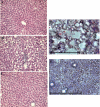Chronic administration of brain-derived neurotrophic factor in the hypothalamic paraventricular nucleus reverses obesity induced by high-fat diet
- PMID: 20164202
- PMCID: PMC2867522
- DOI: 10.1152/ajpregu.00844.2009
Chronic administration of brain-derived neurotrophic factor in the hypothalamic paraventricular nucleus reverses obesity induced by high-fat diet
Abstract
An acute injection of brain-derived neurotrophic factor (BDNF) in the hypothalamic paraventricular nucleus (PVN) reduces body weight by decreasing feeding and increasing energy expenditure (EE), in animals on standard laboratory chow. Animals have divergent responses to a high-fat diet (HFD) exposure, with some developing obesity and others remaining lean. In the current study, we tested two hypotheses: 1) BDNF in the PVN reverses HFD-induced obesity, and 2) animals with higher body fat have a greater physiological response to BDNF than those with less body fat. Eighty-four 10-wk old rats were allowed HFD ad libitum for 9 wk and then prepared with bilateral PVN cannulas. Animals were then divided into tertiles based on their body fat rank: high, intermediate, and low (H, I, and L). Each group was further divided into 2 subgroups and then PVN injected with BDNF or control (artificial cerebrospinal fluid, aCSF) every other day for 3 wk. Energy intake (EI), body weight, and body composition were measured. At study's end, rats were killed to allow measurement of other metabolic indices. In parallel, another 12 rats were fed control diet (CD), PVN-cannulated and injected with aCSF. HFD exposure induced obesity, particularly in the H body fat group, with a significant increase in EI, body weight, fat mass, liver size, and serum glucose, triglycerides, insulin, and leptin. BDNF significantly reduced EI, body weight, body fat, lean mass, and serum metabolic indices. These BDNF effects were greatest in the H body fat group. These data indicate that BDNF reduced HFD-induced obesity and metabolic syndrome-like measures, and the animals with the most body fat had the most significant response to BDNF.
Figures







Similar articles
-
Reduction of high-fat diet-induced obesity after chronic administration of brain-derived neurotrophic factor in the hypothalamic ventromedial nucleus.Neuroscience. 2011 Oct 27;194:36-52. doi: 10.1016/j.neuroscience.2011.07.079. Epub 2011 Aug 5. Neuroscience. 2011. PMID: 21856381 Free PMC article.
-
Brain-derived neurotrophic factor in the hypothalamic paraventricular nucleus increases energy expenditure by elevating metabolic rate.Am J Physiol Regul Integr Comp Physiol. 2007 Sep;293(3):R992-1002. doi: 10.1152/ajpregu.00516.2006. Epub 2007 Jun 13. Am J Physiol Regul Integr Comp Physiol. 2007. PMID: 17567712
-
High-fat feeding alters the cardiovascular role of the hypothalamic paraventricular nucleus.Am J Physiol Regul Integr Comp Physiol. 2010 Mar;298(3):R799-807. doi: 10.1152/ajpregu.00558.2009. Epub 2009 Dec 30. Am J Physiol Regul Integr Comp Physiol. 2010. PMID: 20042687
-
BDNF mediates adaptive brain and body responses to energetic challenges.Trends Endocrinol Metab. 2014 Feb;25(2):89-98. doi: 10.1016/j.tem.2013.10.006. Epub 2013 Dec 19. Trends Endocrinol Metab. 2014. PMID: 24361004 Free PMC article. Review.
-
The Pleiotropic Potential of BDNF beyond Neurons: Implication for a Healthy Mind in a Healthy Body.Life (Basel). 2021 Nov 17;11(11):1256. doi: 10.3390/life11111256. Life (Basel). 2021. PMID: 34833132 Free PMC article. Review.
Cited by
-
Melissa officinalis extract improved high-fat-diet-induced anxiety-like behaviors, depression, and memory impairment by regulation of serum BDNF levels in rats.Avicenna J Phytomed. 2024 Sep-Oct;14(5):617-631. doi: 10.22038/AJP.2024.24343. Avicenna J Phytomed. 2024. PMID: 40255947 Free PMC article.
-
Ablation of intact hypothalamic and/or hindbrain TrkB signaling leads to perturbations in energy balance.Mol Metab. 2015 Aug 18;4(11):867-80. doi: 10.1016/j.molmet.2015.08.002. eCollection 2015 Nov. Mol Metab. 2015. PMID: 26629410 Free PMC article.
-
Feed your head: neurodevelopmental control of feeding and metabolism.Annu Rev Physiol. 2014;76:197-223. doi: 10.1146/annurev-physiol-021113-170347. Epub 2013 Nov 18. Annu Rev Physiol. 2014. PMID: 24274739 Free PMC article. Review.
-
Early generalized overgrowth in boys with autism.Arch Gen Psychiatry. 2011 Oct;68(10):1021-31. doi: 10.1001/archgenpsychiatry.2011.106. Arch Gen Psychiatry. 2011. PMID: 21969460 Free PMC article.
-
BDNF acting in the hypothalamus induces acute pressor responses under permissive control of angiotensin II.Auton Neurosci. 2016 May;197:1-8. doi: 10.1016/j.autneu.2016.02.011. Epub 2016 Mar 2. Auton Neurosci. 2016. PMID: 26948539 Free PMC article.
References
-
- Araya AV, Orellana X, Espinoza J. Evaluation of the effect of caloric restriction on serum BDNF in overweight and obese subjects: preliminary evidences. Endocrine 33: 300–304, 2008 - PubMed
-
- Bagnasco M, Dube MG, Katz A, Kalra PS, Kalra SP. Leptin expression in hypothalamic PVN reverses dietary obesity and hyperinsulinemia but stimulates ghrelin. Obes Res 11: 1463–1470, 2003 - PubMed
-
- Bahceci M, Tuzcu A, Akkus M, Yaldiz M, Ozbay A. The effect of high-fat diet on the development of obesity and serum leptin level in rats. Eat Weight Disord 4: 128–132, 1999 - PubMed
-
- Benjamini Y, Hochberg Y. Controlling the false discovery rate: A practical and powerful approach to multiple testing. J R Statist Soc B, 57: 289–300, 1995
-
- Billington CJ, Briggs JE, Harker S, Grace M, Levine AS. Neuropeptide Y in hypothalamic paraventricular nucleus: a center coordinating energy metabolism. Am J Physiol Regul Integr Comp Physiol 266: R1765–R1770, 1994 - PubMed
Publication types
MeSH terms
Substances
Grants and funding
LinkOut - more resources
Full Text Sources
Other Literature Sources
Medical

